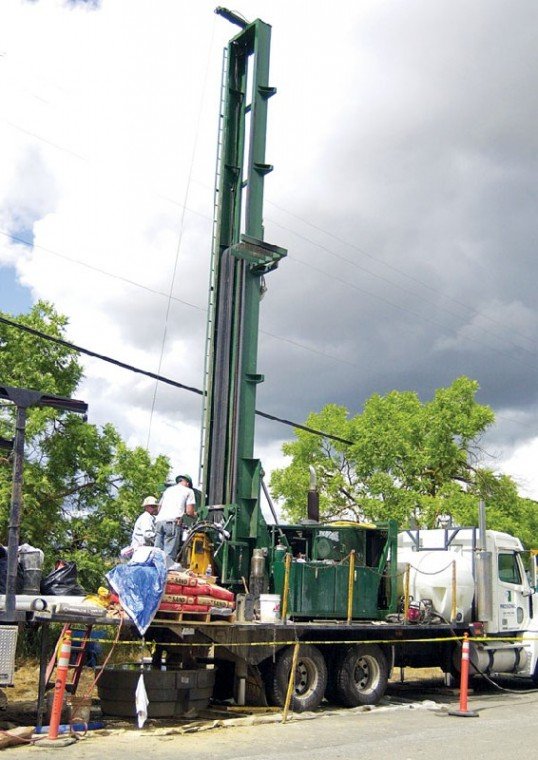Gilroy
– The Olin Corp. has hit bottom. Of the sub-basin, that is.
That at one point the Llagas Sub-basin is 370 feet deep is a
piece of trivia, but it’s one of thousands of facts that will guide
cleanup of the perchlorate in the groundwater beneath Morgan Hill
and San Martin.
Gilroy – The Olin Corp. has hit bottom. Of the sub-basin, that is.
That at one point the Llagas Sub-basin is 370 feet deep is a piece of trivia, but it’s one of thousands of facts that will guide cleanup of the perchlorate in the groundwater beneath Morgan Hill and San Martin.
Friday, Olin will present the first major piece of its final cleanup efforts, a plan to delineate the exact scope and size of perchlorate contamination in local groundwater. The plan has not yet been officially endorsed by the Central Coast Regional Water Resources Board, but approval could come later this month.
“We’re currently reviewing it and getting comments. It’s a good start,” said David Athey, who is supervising cleanup for the regional board. “We may or may not make changes, but our interest is to get moving as quickly as possible. I don’t want the regional board to cause a delay in getting to remediation.”
Athey said he is pleased that Olin’s plan includes installation of eight new wells as part of a network of more than 50 wells to measure perchlorate concentrations at various groundwater levels from Tennant Avenue in Morgan Hill to Highway 152 in Gilroy. The eight wells are located more or less down the center of the plume. None of them will test areas known to be perchlorate-free, a step that could help determine to what contamination level the groundwater should be cleaned.
Olin representative Rick McClure said the new wells will complete the picture the company now has of the groundwater basin.
“The specifically designed monitoring wells will corroborate the data we’re currently using from domestic wells,” McClure said. “We believe these wells will give us a more accurate picture.”
Tracy Hemmeter, a project manager for the Santa Clara Valley Water District, said Wednesday that the district has not yet reviewed the plan, but said the monitoring plan’s effectiveness will determine the success of the clean up.
“It’s a critical piece of work that will supply all the information needed to get a long-term basin cleanup plan,” Hemmeter said. “Without it, we can’t get to the end goal of the cleanup plan.”
Olin has also begun to install four piezometer wells in Morgan Hill north of the contamination source, the company’s former road-flare factory on Railroad Avenue. That area is not part of the final cleanup plan because the source of contamination source has not been proven.
Olin denies responsibility for the northeast flow but it agreed to install the wells, which measure groundwater flow, to help determine the contamination source. As part of that deal, the water district will pursue chemical forensic testing of the plume that may settle the debate. That testing may begin this summer.
Olin also continues to install ion-exchange treatment systems on the worst-contaminated wells in Morgan Hill and San Martin. The treatment system has not yet been certified by the California Department of Health Resources, but has been proven to restore drinking water to background levels.
Olin will continue to provide water until the system has been certified. For now, the company provides bottled water to San Martin residents whose wells test for perchlorate at or above 4 parts per billion, but that is about to change. Later this month, the State Water Resources Control Board is expected to finalize a decision that will allow Olin to provide water only to those residents whose water tests at or above the state public health goal of 6 parts per billion.
Previously, Athey expressed concern that the decision would make it easier for Olin to avoid cleaning the groundwater below the health goal. But the state board is expected to produce a narrowly-crafted order that will not set a dangerous precedent for cleanup projects up and down the state.
“It will be limited solely to drinking water and that should be remembered by everybody,” Athey said.
Once the monitoring plan has been approved by the regional board, Olin will have 30 days to begin installation. Olin must propose a cleanup level no later than Jan. 31, 2006. The feasibility study for the cleanup plan is due June 30, 2006.
If the regional board concurs with the feasibility study, Olin will submit a work plan for cleaning the groundwater basin. The company will have 120 days to start work on the plan once it has been approved by the regional board.
Upcoming
What: Meeting to discuss Llagas
Sub-basin monitoring plan
When: Friday, 2pm
Where: San Martin Lions Club Hall, 12415 Murphy Ave.
Highlights of the monitoring plan:
• Plan will monitor depth and extent of perchlorate contamination
• Uses 8 new wells and 25 existing wells
• A network of more than 50 wells to measure groundwater levels














